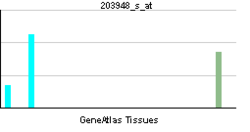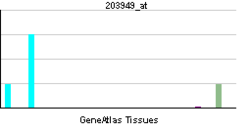- Myeloperoxidase
-
Myeloperoxidase (MPO) is a peroxidase enzyme (EC 1.11.1.7) most abundantly present in neutrophil granulocytes (a subtype of white blood cells). It is a lysosomal protein stored in azurophilic granules of the neutrophil. MPO has a heme pigment, which causes its green color in secretions rich in neutrophils, such as pus and some forms of mucus.
Contents
Structure
The 150-kDa MPO protein is a dimer consisting of two 15-kDa light chains and two variable-weight glycosylated heavy chains bound to a prosthetic heme group. Three isoforms have been identified, differing only in the size of the heavy chains.[1] It contains a calcium binding site with seven ligands, forming a pentagonal pyramid conformation. One of the ligands is the carbonyl group of Asp 96. Calcium-binding is important for structure of the active site because of Asp 96's close proximity to the catalytic His95 side chain.
Function
MPO produces hypochlorous acid (HOCl) from hydrogen peroxide (H2O2) and chloride anion (Cl-) (or the equivalent from a non-chlorine halide) during the neutrophil's respiratory burst. It requires heme as a cofactor. Furthermore, it oxidizes tyrosine to tyrosyl radical using hydrogen peroxide as an oxidizing agent.[2]
Hypochlorous acid and tyrosyl radical are cytotoxic, so they are used by the neutrophil to kill bacteria and other pathogens.
Inhibitors of MPO
Azide has been used traditionally as an MPO inhibitor, but 4-aminobenzoic acid hydrazide (4-ABH) is a more specific inhibitor of MPO.[3]
Genetics
The gene is located on chromosome 17 (17q23.1).
Role in disease
Myeloperoxidase deficiency is a hereditary deficiency of the enzyme, which predisposes to immune deficiency.[4]
Antibodies against MPO have been implicated in various types of vasculitis, most prominently crescentic glomerulonephritis and Churg-Strauss syndrome. They are detected as perinuclear ANCAs (pANCAs), as opposed to the cytoplasmic ANCAs (cANCAs) against proteinase 3 (PR3), which are strongly associated with Wegener's granulomatosis.
Recent studies have reported an association between myeloperoxidase levels and the severity of coronary artery disease.[5] It has been suggested that myeloperoxidase plays a significant role in the development of the atherosclerotic lesion and rendering plaques unstable.[6][7]
Medical uses
An initial 2003 study suggested that MPO could serve as a sensitive predictor for myocardial infarction in patients presenting with chest pain.[8] Since then, there have been over 100 published studies documenting the utility of MPO testing. Most recently, Heslop et al. reported that elevated MPO levels more than doubled the risk for cardiovascular mortality over a 13-year period, and measuring both MPO and CRP (C-reactive protein; a general and cardiac-related marker of inflammation) provided added benefit for risk prediction than just measuring CRP alone.[9]
Immunohistochemical staining for myeloperoxidase used to be administered in the diagnosis of acute myeloid leukemia to demonstrate that the leukemic cells were derived from the myeloid lineage. However, the use of myeloperoxidase staining in this setting has been supplanted by the widespread use of flow cytometry. Myeloperoxidase staining is still important in the diagnosis of extramedullary leukemia, or chloroma.
Myeloperoxidase is the first and so far only human enzyme known to break down carbon nanotubes, allaying a concern among clinicians that using nanotubes for targeted delivery of medicines would lead to an unhealthy buildup of nanotubes in tissues.[10]
See also
- Chloroma
References
- ^ M Mathy-Hartert et al. (1998). "Purification of myeloperoxidase from equine polymorphonuclear leucocytes". Can J Vet Res. 62 (2): 127–132. PMC 1189459. PMID 9553712. http://www.pubmedcentral.nih.gov/articlerender.fcgi?tool=pmcentrez&artid=1189459.
- ^ Heinecke JW, Li W, Francis GA, Goldstein JA. Tyrosyl radical generated by myeloperoxidase catalyzes the oxidative cross-linking of proteins. J Clin Invest 1993;91:2866-72. PMID 8390491.
- ^ Kettle AJ, Gedye CA, Winterbourn CC (January 1997). "Mechanism of inactivation of myeloperoxidase by 4-aminobenzoic acid hydrazide". Biochem. J.. 321 ( Pt 2): 503–8. PMC 1218097. PMID 9020887. http://www.pubmedcentral.nih.gov/articlerender.fcgi?tool=pmcentrez&artid=1218097.
- ^ Kutter D, Devaquet P, Vanderstocken G, Paulus JM, Marchal V, Gothot A. Consequences of total and subtotal myeloperoxidase deficiency: risk or benefit? Acta Haematol 2000;104:10-5. PMID 11111115.
- ^ Zhang R, Brennan ML, Fu X, et al. (November 2001). "Association between myeloperoxidase levels and risk of coronary artery disease". JAMA 286 (17): 2136–42. doi:10.1001/jama.286.17.2136. PMID 11694155. http://jama.ama-assn.org/content/286/17/2136.long.
- ^ Nicholls SJ, Hazen SL (June 2005). "Myeloperoxidase and cardiovascular disease". Arterioscler. Thromb. Vasc. Biol. 25 (6): 1102–11. doi:10.1161/01.ATV.0000163262.83456.6d. PMID 15790935. http://atvb.ahajournals.org/cgi/content/full/25/6/1102.
- ^ Lau D, Baldus S (July 2006). "Myeloperoxidase and its contributory role in inflammatory vascular disease". Pharmacol. Ther. 111 (1): 16–26. doi:10.1016/j.pharmthera.2005.06.023. PMID 16476484.
- ^ Brennan M-L, Penn MS, Van Lente F, Nambi V, Shishehbor MH, Aviles RJ, Goormastic M, Pepoy ML, McErlean ES, Topol EJ, Nissen SE, Hazen SL. Prognostic value of myeloperoxidase in patients with chest pain. N Engl J Med 2003;349:1595-604. PMID 14573731.
- ^ Heslop CL, Frohlich JJ, Hill JS. Myeloperoxidase and C-reactive protein have combined utility for long-term prediction of cardiovascular mortality after coronary angiography. J Am Coll Cardiol 2010; 55: 1102-9. PMID 20223364.
- ^ Kagan VE, Konduru NV, Feng W, Allen BL, Conroy J, Volkov Y, Vlasova II, Belikova NA, Yanamala N, Kapralov A, Tyurina YY, Shi J, Kisin ER, Murray AR, Franks J, Stolz D, Gou P, Klein-Seetharaman J, Fadeel B, Star A, Shvedova AA (April 2010). "Carbon nanotubes degraded by neutrophil myeloperoxidase induce less pulmonary inflammation". Nat Nanotechnol 5 (5): 354–9. doi:10.1038/nnano.2010.44. PMID 20364135. Lay summary – popsci.com.
PDB gallery 1cxp: CRYOGENIC CRYSTAL STRUCTURE OF HUMAN MYELOPEROXIDASE ISOFORM C1d2v: CRYSTAL STRUCTURE OF BROMIDE-BOUND HUMAN MYELOPEROXIDASE ISOFORM C AT PH 5.51d5l: CRYSTAL STRUCTURE OF CYANIDE-BOUND HUMAN MYELOPEROXIDASE ISOFORM C AT PH 5.51d7w: CRYSTAL STRUCTURE OF HUMAN MYELOPEROXIDASE ISOFORM C COMPLEXED WITH CYANIDE AND BROMIDE AT PH 4.01dnu: STRUCTURAL ANALYSES OF HUMAN MYELOPEROXIDASE-THIOCYANATE COMPLEX1dnw: HUMAN MYELOPEROXIDASE-CYANIDE-THIOCYANATE COMPLEX1mhl: CRYSTAL STRUCTURE OF HUMAN MYELOPEROXIDASE ISOFORM C CRYSTALLIZED IN SPACE GROUP P2(1) AT PH 5.5 AND 20 DEG C1myp: X-RAY CRYSTAL STRUCTURE OF CANINE MYELOPEROXIDASE AT 3 ANGSTROMS RESOLUTIONOxidoreductases: peroxidases (EC 1.11) 1.11.1.1-14 Catalase · Cytochrome c peroxidase · Eosinophil peroxidase · Glutathione peroxidase (GPX 1, 2, 3, 4, 5, 6, 7, 8) · Horseradish peroxidase · Lactoperoxidase · Myeloperoxidase · Thyroid peroxidase · Deiodinase (Iodothyronine deiodinase, Iodotyrosine deiodinase)1.11.1.15 (peroxiredoxin) Antimicrobial peptides: Granulocyte granule contents Azurophilic granules (1°) Myeloperoxidase · Defensins · neutral serine proteases (Proteinase 3) · Lysozyme · Bactericidal/permeability increasing protein · CollagenaseSpecific granules (2°) Categories:- Human proteins
- EC 1.11.1
- Hemoproteins
Wikimedia Foundation. 2010.











